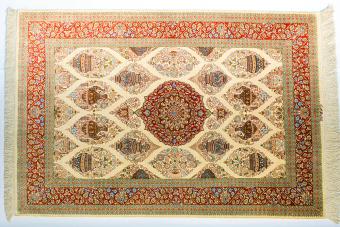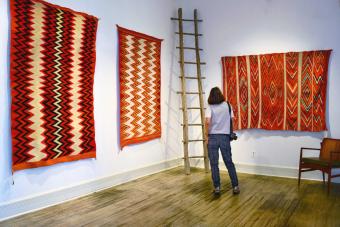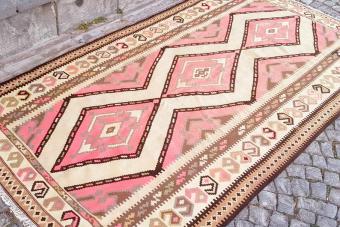
Antique rugs provide a unique combination of beauty and history to any room. Learning how to identify your rug can help you learn a bit about its past, understand how to care for this type of antique, and even get a sense of its value. There are several clues, many of which you can interpret yourself, that can help with identifying rugs that you're interested in and knowing which ones are a great deal and which ones can go back in the bin.
Determine the Type of Rug by Origin
According to Nazmiyal Antique Rugs, there are dozens of different rug styles from past eras. The designs vary, depending on the area where they were made and the production techniques used to create them. In fact, you can find antique rugs from just about every culture in the world.
To begin identifying a rug, examine its construction and appearance and compare it to the following common types.
Persian and Oriental Rugs
Oriental rugs come from all over Asia, including as far west as Turkey and east as China, with India and the Middle East being a particularly beloved region for these rugs. Persian rugs are one type of Oriental rug, and they come from the area that was once the kingdom of Persia (modern day Iran). Since this area of the world has been making rugs for thousands of years, historic examples of their rug-making talents are highly collectible.

There are a number of classical design elements that can help you identify an Oriental rug, although every rug made in any style is unique:
- Decorative motifs - Oriental rugs frequently feature motifs like paisley designs and central medallions and rosettes.
- Symmetry and border - These rugs usually have a bordered area with a medallion or an all-over consistent design. Almost all rugs feature symmetry.
- Bound and fringed edges - You'll see both bound edges and fringed edges.
- Consistent colors - Common colors to find on these rugs include ivory, black, shades of red, and blue.
- High piles - Many rugs feature a higher pile, but you'll also see flat-woven Oriental pieces.
Unfortunately for common collectors, the most luxurious pieces are far too fragile and expensive to own privately. However, there are a lot of beautiful, high-quality rugs to come out of the Persian region in the 19th century, and they are considered by many to be the most desirable of the broadly accessible rugs. Of these Middle Eastern rugs, there are a few notable styles that Persian rugs were designed with, one of which might connect to you as a collector:
- Bakshayesh - Popular 19th century Persian rug style featuring geometric designs and a color palette of pinks, reds, ivories, and blues.
- Bijar - Home-woven rugs, Bijar rugs are known for their weight and density thanks to the weavers beating weft strands into the rows to create a compact, heavy weave.
- Esfahan - Esfahan rugs are a very popular type of super colorful rug (known particularly for its special terra cotta-like red hue) and were made with a myriad of design motifs such as geometric medallions and nature scenes.
- Heriz - Heriz rugs are renowned for their geometric motifs, such as flowers taking on a less curvilinear shape, and they came in a variety of warm-toned hues such as earthy reds, pinks, greens, and more.
- Kashan - Kashan rugs differ from many of the historic Persian rugs in that they were predominately made of fine silks, making them an extremely valuable collectible because of the labor that went into weaving the fine silk strands.
Continental European Rugs
Although the rug-making tradition isn't as well established as in the Oriental region, the Europeans have been making rugs and carpets for centuries. These rugs have some unique characteristics:

- Asymmetrical designs - In contrast to Oriental rugs, these pieces often featured asymmetrical designs.
- Matching architecture to design - Sometimes, a rug matched the design of a decorative ceiling.
- Muted colors - You'll see colors of gold, soft rose, and green, among others. Generally, the tones of European rugs are muted.
- Floral motifs - Flower motifs and garlands are very common.
- Multiple weave styles - They may have a pile or be flat-woven.
American Rugs
You'll see a number of different styles and construction methods in American rugs from past eras. Expect to find some of the following:

- Indigenous rugs - Indigenous communities of the Americas are well-known for their beautiful fiber arts. For example, Navajo rugs feature a tight, flat weave and commonly have colors of black, brown, ivory, red, and sometimes blue. Most feature geometric designs.
- Art Nouveau rugs - Art Nouveau rugs have designs that were popular during the 1890s through 1910, including nature motifs and fluid lines.
- Art Deco rugs - Art Deco rugs have strong geometric images that were popular in the 1920s and 1930s.
Scandinavian Rugs
Countries in the Scandinavian region also have a strong rug-weaving tradition, dating back centuries. You'll notice some classic features in this kind of rug:

- Geometric designs - Scandinavian rugs often have strong geometric designs.
- Asymmetrical designs - These rugs are often asymmetrical.
- Focus on visual simplicity - Many have an abstract simplicity in the main design, rather than being a figurative representation of something.
- Multiple weave styles - Some have a high pile, while others are flat woven.
- Rainbow of colors - You'll see these rugs made out of almost any color.
Examine the Weaving Style
Another layer to rug identification is looking at the way the textiles were woven together. Most antique rugs were crafted out of wool, jute, cotton, or another natural fiber, but their construction methods can vary. Both historic and modern artisans create rugs in a number of different ways, but there are a few primary types of antique rug construction.
Flat-Woven
Flat weaving involves stretching fibers, called the "weft," on a loom, and then interweaving additional fibers, called the "warp." This type of rug won't have any pile, or fiber ends, showing on the surface. Flat weaving is a classic style that lends itself to simple designs. In most cases, antique flat-woven rugs were made by hand.

Hand-Knotted
Another way antique rugs are constructed is through hand knotting, according to the Nazmiyal Collection. There are a number of different knotting styles, but all of them involve tying fiber pieces around the weft on the rug loom. These pieces can be various lengths, but they will provide pile. A hand-knotted rug may have an open or closed back. This means that when you look at the underside of the rug, you may be able to see the fiber pieces. Alternatively, the back may be covered with fabric.

Additional Antique Rug Styles to Collect
Depending on the type of rug you have, you may also see the following, less common, construction styles:
Hooked Rugs
Hooked rugs have a higher pile made by hooking yarn through a rug backing. They came into popularity in the 1840s, and are known for their distinctively rougher effect.

Braided Rugs
Braided rugs are another American folk tradition. They were constructed out of braided strips of wool fabric that were then sewn together in a flat, continuous spiral. This domestic craft is still practiced by many people today, and you can find braided rugs at home goods retailers around the world.

Look for Clues to Determine Their Age
Your rug may include a few clues that can help you determine its age, as well. Knowing when the rug was woven will give you a more accurate sense of the value and history of your piece. Try these tips for discovering how old your rug is:

- Woven in dates - Look for dates woven into the design of the rug. Oriental or Persian rugs often have Arabic numerals woven into the border area. Although this isn't the most reliable method of dating a rug, it does provide a starting point.
- Lack of distinct pattern - In the case of braided rugs, Antique Homes reports that many rugs were crafted from old wool clothing. This means that the oldest braided rugs rarely have a distinct pattern.
- Imperfect dimensions or colors - Hooked rugs were always unique until the 1868 invention of rug templates, according to Country Living. This means that if your hooked rug has an unusual scale or color choice or just seems imperfect, it may be from before this era.
- Colors and fading - Examine the colors. According to A Buyer's Guide to Oriental Carpets, bright synthetic rug dyes weren't available until the 1920s. If the rug appears uniformly faded, it may be from before this time.
Select the Best Rugs Based on Their Value
Not only is it important to be able to determine what type of rug you've uncovered in a used furniture retailer, but knowing which of these types and patterns can bring in big profits can mean the difference between an immediate sell or a family heirloom that you hold on to. Generally, antique rugs can be incredibly valuable, easily selling for hundreds of thousands of dollars. In fact, the most expensive rug ever sold was a 17th century Persian rug owned by William Clark that garnered a whopping $33.8 million winning bid.
Of course, the Persian rug's reputation precedes it, and yet its reputation is absolutely true. Persian rugs are largely the most valuable historic rugs on the market and are a must-have for any rug collector. While you probably won't stumble across a million dollar Persian rug in your grandmother's living room, you can keep your eyes peeled for the (in comparison) moderately priced Ziegler Mahal print Persian rugs. According to Benham Rugs, these large ornamental rugs are known for their beautiful colors and decorative backgrounds featuring motifs like flowers and vines, and are valuable thanks to how rare they are to find.
For the untrained eye, there are a few characteristics that denote value in antique and vintage rugs that you can observe with just a cursory investigation:
- Detail - The more intricate detail there is, the harder the rug was to make and, therefore, the more valuable it is. This really only applies to hand-woven rugs, and when you're looking for it, you want to see how much space is left between each design element. If there's a lot, it's probably not worth that much money.
- Materials - Although wool is a mainstay for creating rugs, finer fabrics have been used to create luxurious statement pieces throughout history. Silk rugs, in particular, can be very valuable because of how much more difficult it is to create detailed designs with the thin threads.
- Number of knots - The higher the knots in an antique rug, the finer it's considered to be and therefore, the more valuable it'll be to an appraiser or auction house.
- Age - While determining precise age is best left up to the experts, the older the rug is, the more valuable it is because of how fragile the remaining textiles are.
Ask Previous Owners Questions for More Information
If you inherited your antique rug or are considering purchasing one, ask questions about its history. You'll be surprised what you can learn about a rug's provenance and identity with a few well-thought-out questions. Try these:
- How much do you know about the people who have owned this rug?
- Where might this rug have been used in the home?
- Are there any stories about this rug?
- Does the style of the rug signify anything in particular?
- Are there any documents that go with this rug, such as receipts, letters, or photographs?
Resources to Help You Identify Antique Rugs
With the huge amount of colors and minute prints, the number of different rugs out there can feel seriously overwhelming. Yet, you don't have to become an expert overnight, and these print and digital resources are here to make your identification job much easier.
Print Resources
Here are a few of the best instructional guides on antique and vintage rug identification:
- Oriental Rugs: The Collector's Guide to Selecting, Identifying, and Enjoying New and Antique Oriental Rugs by George W. O'Bannon
- Oriental Rugs: An Illustrated Lexicon of Motifs, Materials, and Origins by Peter F. Stone
- Oriental Rugs: The Illustrated World Buyer's Guide by Janice Summers
- The Bulfinch Guide to Carpets: How to Identify, Classify, and Evaluate Antique Carpets and Rugs by Enza Milanesi
Digital Resources
In addition to print guides, there are also a few places online that offer some unique resources that can help you identify rugs with more authority.
- The Rug Book Shop - The Rug Book Shop is actually a brick-and-mortar shop whose website features all of the specialized books that they sell with a detailed explanation of what they're about. You can purchase books from the shop by emailing them and using your Paypal account or by visiting their store.
- Jozan Directory - Jozan's rug directory is a comprehensive collection of sellers, auction sites, and identification resource links from places around the world.
- The Practical Book of Oriental Rugs - Thanks to Project Gutenberg, this large compendium discussing oriental rugs is available online for free.
Consider Consulting an Appraisal
If you suspect that you have an antique rug of some value, consider having it professionally appraised. Even if you aren't planning to part with your treasure, an appraisal is important for insurance purposes. In addition, a professional appraisal is the best way to narrowly identify an antique rug; two notable patterns might look the same to an amateur's eyes, but to an appraiser they can be vastly different. During the appraisal, you can learn a lot about the style, history, and age of your piece.
You Don't Want to Stain These Rugs
Antique rugs, such as beautiful Navajo rugs, come in hundreds of different style, shapes, colors, and patterns, so there's a lot to consider when trying to identify these beautiful works of art. Take your time and examine each aspect of your rug for clues about its fascinating past, as well as about whether it's something to pack away or keep on display in the high-traffic areas of your home.







